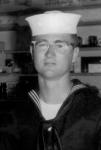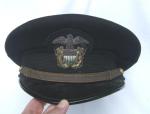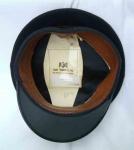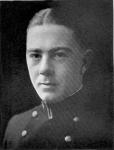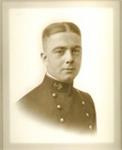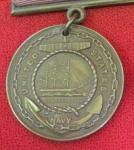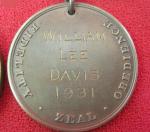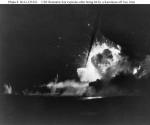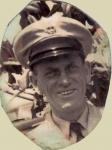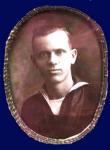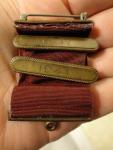
army historian
For Deletion-
Posts
1,543 -
Joined
-
Last visited
-
Days Won
3
Content Type
Profiles
Forums
Blogs
Gallery
Events
Store
Everything posted by army historian
-
ETN2 Larry Robert Christensen US Navy 2 Jan 1958 to 1 Jun 1962 US Navy Res. (2Jun 1962 to 1 Jun 1964) US Navy Res. (24 Jun 1971 to 6 Apr 1973) US Coast Guard Res. (7 Apr 1973 to 6 Apr 1977) ETN2 Larry Robert Christensen Awards and Decorations: Bar Mounted: Navy Good Conduct Medal National Defense Service Medal USS Rupertus DD-851 I meet with Larry a number of times. The first time I helped him write for his father’s WW1 Victory Medal. Larry gave me the WW1 Victory Medal and his Navy Good Conduct Medal. He said “he only wanted to see it”. The last time was in Nov 2009 at his home – I interviewed him and he gave me his and his father’s pictures and paperwork to copy, which I did and returned them to him. I really liked Larry, he was a good man, the world is a little sadder now that he is gown. ETN - Electronics Technician (Communications). Larry Robert Christensen obituary Larry was born on May 15, 1938 and went to be with the Lord after losing his seven-year battle with cancer on November 3, 2010. He passed away at about 9 pm while resting in the arms of his loving wife, Valerie. Raised in Ferndale, he graduated from Ferndale High School in 1956 and from Humboldt State College in 1965 with a Bachelor's Degree in Psychology. He immediately accepted a job as a Social Worker with the Humboldt County Welfare Department and worked there for 35 years before retiring in January of 2001. Larry proudly served in the US Navy from June 1958 to June 1962 as an Electronics Technician. He joined the Naval Reserve Unit in Eureka in 1971 and transferred to the Coast Guard Reserve in 1973, serving there for four years. Larry is survived by his wonderful wife Valerie of Eureka; son Robert of Harrisonburg, VA; daughter Linda Scott and her husband Greg; daughter Karen Baas; granddaughter Karissa Knourek and her husband Josh, granddaughters Breanna Scott, MaKayla Scott, Katelyn Baas, and Ashlyn Baas; great-granddaughter Peyton Knourek, all of Redding, CA; and mother-in-law Ann Verbich and brother-in-law Ron Verbich, both of Eureka. He was preceded in death by his father Robert in 1962, mother Rosamond in 2009, and infant great-grandson Colton Knourek. Larry enjoyed bicycling, walking, photography, reading his Bible and historical adventure novels, trips on Customer Coach, and especially being with his grandchildren and great-grandchild. He had an incredibly bright and sharp sense of humor and was making us laugh right up to the end. Larry and family are especially grateful to Eureka Internal Medicine's oncology department: Dr. Majer and nurse Rose, infusion nurses Kathleen, Leeann, and Sandy, and all of the staff who made a frightening and difficult situation so much more tolerable; and to our church family at Faith Center Foursquare Church: Pastors Matt and Gary, Chris, Ron and Shirley, Jim, Rick; and all the other wonderful friends and family who kept us in their prayers, sent cards, and who were always there to talk and to help us keep our perspective on life and death and remind us of God's promise. We are also grateful to the fine folks at Hospice of Humboldt who gave Larry great care and dignity during the final days of his life. At Larry's request there will be no formal services. In lieu of flowers donations in his memory may be made to Faith Center Foursquare Church's Building Fund, 1032 Bay Street, Eureka, CA 95501, or to a favorite charity. "I may not get better But some day I'll be free. 'Cause I am not this body That imprisons me." - John Darnielle, "Isaiah 45:23" Arrangements are under the care of Pierce Mortuary Chapel, Eureka, CA 707-442-3751, www.piercemortuarychapels.com Please sign the guest book at www.Times-Standard.com, click obits. Published in Eureka Times-Standard on November 7, 2010 I met and liked Larry – he was a good man.
-
Uncategorised WW1 Observer Certificate
army historian replied to a topic in United States of America
Great certificate - the only one I've seen - great research also. Thanks for sharing. -
Flea Market WW2 Navy CPO Hat
army historian replied to army historian's topic in United States of America
Yes I'm very taken with the embroidered insignia also. George -
Thanks Paul - I appreciate the comments. I am hoping the Archives can supply a little more information. I should have mentioned that: Davis was assigned to the USS Fall River CA-131 on 11 Aug 1945, he probably served on her until her decom in 1947. If so he would have qualified for the WW2 Navy Occupation Medal W/bar “Asia”, and the China Service Medal (Extended). The USS Fall River served a tour of duty in the Far East as flagship of Cruiser Division 1 from 12 January 1947 to 17 June 1947. Davis may have retired in Nov. 1947, or later. Fall River; and commissioned on 1 July 1945, Captain David Stolz Crawford in commanding. On 31 October 1945, Fall River arrived at Norfolk, out of which she sailed in experimental development operations until 31 January 1946. The cruiser was assigned to JTF 1, organized to conduct Operation Crossroads, atomic weapons tests in the Marshall Islands in the summer of 1946. To prepare for this duty, Fall River sailed to San Pedro, California, where from 16 February to 6 March she was altered to provide flagship accommodations. Arriving at Pearl Harbor on 17 March, she embarked Rear Admiral F. G. Fahrion, commander of the target vessel's group for the tests, and with him sailed in the Marshalls between 21 May and 14 September. After west coast training, Fall River served a tour of duty in the Far East as flagship of Cruiser Division 1 from 12 January 1947 to 17 June 1947. Authorized during WWII but completed too late to see service in that conflict, the Fall River was caught in the post-war economizing measures, despite her recent completion and lack of wartime damage. She returned to Puget Sound Navy Yard, where she was placed out of commission in reserve on 31 October 1947. Stricken on 19 February 1971, and sold on 28 August 1972 to Zidell Explorations Corp., Portland, Oregon. George
-
Well it's taken a long while but after paying $70.00 to the National Archives I received about 2" of copy paperwork from Davis' enlisted file. Since it stops in 1943 (as Lt. J.G.) I called and asked for the rest (will see). There is request and transmittal letter for the Yangtze Service medal M.No. 2367 (so that is verified), for service on the USS John D. Edwards (DD-216) also on the USS Blackhawk (AD-9) these cover the entire period 1930-1932. Here is a condensed record: Entered service 25 Nov. 1927 at Hannibal, Missouri, with Father’s consent (letter dated 25 Nov 1927. Discharged 24 Sep 1931 EM3 26 Mar. 1929 USS Meyer (DD-279) promoted from F3c to F2c Note: Early in 1929 the destroyer began inactivation overhaul and on 15 May 1929 was decommissioned at San Diego. On 17 June she was towed to Mare Island for scrapping. Struck 25 November 1930, her materials were sold 25 February 1932. 15 May 1929 transferred from USS Meyer to USS Reno DD-303 22 Jun 1929 F2C qualified as Expert Rifleman USS Reno. 29 Jun 1929 transferred from USS Reno to USS John D. Edwards (DD-216). 18 Aug 1929 entered the Asiatic Squadron – USS John D. Edwards (DD-216) operated along the West Coast until 1 August 1929 when she sailed for the Far East, arriving Yokohama 26 August. Edwards undertook a lengthy duty as part of the Asiatic Fleet. Operating out of the Philippines along the Chinese Coast and off Japan, she guarded American interests during the Sino-Japanese War in the late 1930s, underwent training and battle practice, and operated with the Yangtze River Patrol, South China Sea Patrol, and the Neutrality patrols. 16 Oct 1929 promoted to F1c. 14 Mar 1929 to R/S Cavite P.I for course at the Sound Motion Picture Technicians School (6 weeks). 21 Apr 1931 complete course. 12 Jan 1930 USS John D. Edwards (DD-216) qualified as Marksman. 30 Jun 1930 qualified as Motion Picture Operator. 25 Jan. 1931 USS John D. Edwards (DD-216) promoted from F1c to EM3 Manila, P.I. 25 Sep 1931 USS John D. Edwards (DD-216) re enlisted at Chefoo, China (4 years). Discription: age 21 years 11 months, Height 5’8”, weight 145 lbs, eyes Brown, Hair Dk. Brown, complexion Ruddy. 20 May 1932 transferred to USS Blackhawk AD-9 (Destroyer Squadron Five) 25 Feb. 1933 USS Blackhawk request for Good Conduct Medal Manila, P.I. 25 Feb. 1933 USS Blackhawk request for Yangtze Service Medal (service John D. Edwards) Manila, P.I. 20 May 1933 USS Blackhawk received Navy Good Conduct Medal engrave “William Lee Davis 1931”. 21 Aug 1933 received Yangtze Service Medal M. No. 2367 25 Sep 1933 transferred to US Peary (DD-226). 12 Jun 1934 – 20 Aug 1934 transferred to USS Chaumont (transport) 20 Aug 1934 received on the USS Barney (DD-149) 21 Mar 1935 Received Gas Mask instruction at Destroyer Base San Diego, CA 10 Jun 1935 Appointment Electrician Mate 2nd. 24 Sep 1935 USS Barney Discharged this date with Honorable Discharge # C158527 by reason of expiration of enlistment: no time lost: Is recommended for Good Conduct Medal, having the required marks; net service 7 yrs, 10 months; on current enlistment: 4 years; final average all marks: 3.78. At San Diego, CA. 14 Feb1936 received Good Conduct Pin engraved “William Lee Davis, 1935” 9 Nov 1936 transferred from USS Barney to R/S Phila. Temp duty transfer to USS Winslow 17 Feb 1937 transferred to USS Winslow (DD-359) 1 Oct 1937 designation as Mail Clerk USS Winslow 16 Feb 1938 USS Winslow (DD-359) promoted to EM1c 26 Feb 1938 USS Winslow (DD-359) 15 Jul 1938 designation as Mail Clerk USS Winslow revoked 16 Jul 1938 trnsferred to Naval Research Lab., Washington D.C. for training interior Communications School. 13 Dec 1938 Naval Research Lab., Washington D.C. extension of enlistment 3 years 27 Jan 1939 transferred to R/S Norfolk, VA to USS Arkansas for duty on USS Sterett. 8 Feb 1939 trans to USS Arkansas 3 Apr 1939 transferred to Navy Yard Charleston, S.C. for duty USS Sterett 15 Aug 1939 transferred to USS Sterett upon commissioning 20 Sep 1939 Agreement to extend cancelled discharged C-230827 – for re enlistment and recommended for Good Conduct Medal. 22 Sep 1939 Re enlisted on USS Sterett for 4 years. Note: Trade School Sound Motion picture technician Interior Communication School. 16 Dec. 1939 received Good Conduct pin Engraved “Davis, William Lee 1939” 6 Mar 1940 received gas instruction and passed through gas chamber. 12 Oct 1940 transferred from USS Sterett to USS Henley (DD391) Pearl Harbor, H.T. 28 Feb 1941 received appointment as Chief Electrician’s Mate(AA). 30 Apr. 1941 recommended for examination for Warrant Electrician. 18 Jul 1941 acting appointment Warrant Electrician USS Henley 7 Dec 1941 on Henley during Japanese attack. 15-22 Dec. 1941 Wake Island relief mission. 10 Feb. 1943 Commissioned Lieutenant (JG) USNR End National Archives More information: According to the July 1944 Navy Register: Lieutenant William Lee Davis with temporary appointment on 1 July 1944 to Lieutenant File No. 102182. 13 Aug 1945 Navy Report of Change USS Fall River CA-131 for: Name File # Rank Davis, William L 102182 Lieutenant USN Trans 11 Aug 1945 from Naval Landing Forces Depot, Albany, CA for duty on the USS Fall River. Not sure but appears to have retired in 1947. It appears he earned all the WW2 medals on his bars, and the Navy WW2 Occupation with "Asia" bar, and the China Service Medal (Extend) on the USS Fall River.
-
Flea Market WW2 Navy CPO Hat
army historian replied to army historian's topic in United States of America
Thanks Paul - yes you don't see CPO's in blue too often this is the second one I've had. In fact you don't see a lot of the offer's in blue either. Here's an Officer's cap. IrishGunner I have not gotten much on Robert L. Henderson. But his serial number indicates pre-1927 service. I found one in the 1930 Census at: Coco Solo Submarine base Canal Zone Panama on the S-12. Then nothing until 5 Mar 1945 to 1 Jul 1945, except a 1940 Census which lists him and his wife living in Eureka, CA (where the cap was found), he is listed as a Electrical laborer. Here was born in 1904 in Texas, died Eureka, CA 1971. -
I have had this group awhile - but another member asked to see it, so here it is. Uniform and medal group. Rear-Admiral Hubbard Frederick Goodwin’s Medals and awards double bar mounted: Bronze Star Medal + V WWI Victory Medal American Defense Medal + Fleet bar American Campaign Medal Asiatic Pacific Campaign with 1 Silver, and 4 Bronze Stars (9 campaigns) WWII Victory Medal WWII Naval Occupation Medal + Asia bar National Defense Medal Navy Expert Pistol Medal Philippine Presidential Unit Citation (not mounted) Philippine Liberation Medal with 2 Bronze Stars Hubbard Frederick Goodwin was born 28 Mar 1899 at New Heaven, CT. He served during World War 1, see photograph at end of article Golden wedding anniversary of Horace and Elizabeth Hobbs, July 3, 1917. The caption reads “Absent were Walter Scott, and Hubbard Goodwin and Horace Eastow Hobbs, both of whom were in World War I service.” Hubbard F. Goodwin attended Sheffield Scientific School, Yale University and graduated from the U.S. Naval Academy. Since he is listed as entering the Navy on 3 Jun 1922. He was in the Class of 1922, serving at the Academy from 11 Jun 1918 to 3 June 1922. Hubbard’s service number was 57574. He served throughout WW2 and until his retirement on 1 Jul 1953 at the age of 54. He was a Captain and was placed on the Retired list as a Rear Admiral. Goodwin’s SS# was 562-66-2033; he is not in the SS Death records, as he retired from the Navy. Rear-Admiral Hubbard Frederick Goodwin died 1 Nov 1974 in San Diego, CA. From his service record he served on the USS Rochester from July 1922 to June 1925. Goodwin next served at the U.S. Navy Torpedo Station, Newport, R.I. from June 1925 to Dec. 1925 when he was assigned to the Destroyer USS Breck DD-283 from Jan. 1926 to June 1929. Breck was attached to Destroyer Division 25. As a unit of that Division she served with United States Naval Forces Europe, between June 1926 and June 1927 showing the flag along the European and North African coasts and engaging in target and engineering competition. Upon returning to the United States she put in at New York Navy Yard and then proceeded to Newport where she embarked Naval Reserves for the training cruise with the Scouting Fleet. The succeeding years were similar in the established routine of gunnery practice, war games, and maneuvers until the end of September 1929 when Breck arrived with other units of Destroyer Squadron 9 at Philadelphia Navy Yard, ending her active service. Breck was decommissioned 1 May 1930. In Jul 1929 Goodwin was reassigned to at the U.S. Navy Torpedo Station, Newport, R.I. until Jul 1931 when he was assigned to the Light Cruiser USS Milwaukee. The Milwaukee served primarily in the Pacific during the decades between the world wars. From Jun 1934 to Jul 1936 Goodwin served at the Naval Ordnance Plant, South Charleston, WV. This was Naval Plant #5 (NP5) working on Armor and Armor piercing projectiles. He was next assigned to the Destroyer Tender USS Whitney, AD-4 from Jul 1936 to June 1939. From Jul 1939 to Oct 1940 Goodwin Commanded the Ocean going Tugboat USS Mahopac. From Oct 1940 to May 1941 Goodwin served at the U.S. Navy Receiving Station, Puget Sound, WA. He was next assigned to the U.S. Navy Torpedo Station, Newport, R.I. from May 1941 to Oct 1943, when he was assigned to the Heavy Cruiser USS New Orleans as her Executive Officer. He was promoted to Captain 10 Jul 1943 before being assigned to the USS New Orleans. Goodwin served on the USS New Orleans from Oct 1943 to May 1945 and participated in 9 campaigns, earning the Bronze Star Medal with the combat “V” device (awarded for Valor in Combat). His compiled list of campaigns is as follows: Gilbert Islands Operations Marshall Islands Operation Asiatic-Pacific raids (1944) Western New Guinea Operations Marianas Operations Western Caroline Island Operations Leyte Operation Luzon Operation Okinawa Gunto Operation (both USS New Orleans and USS Granville) In June 1945 Goodwin became the First Commanding Officer (and Plank Owner) of the New Fast Attack Transport the USS Granville. The USS Granville (APA-171), 1944-1973 was a 12,450-ton Haskell class attack transport built at Portland, Oregon, was commissioned in November 1944. She carried passengers to the central Pacific during the first few months of 1945 and, in April and May, transported Soldiers to Okinawa. Having completing that mission, she brought casualties back to the U.S. from the western Pacific combat zone and made another trip to Okinawa before Japan agreed to surrender in mid-August. For the next two months Granville supported the occupation of Japan. She was employed on Operation "Magic Carpet", the great effort to return service personnel from the Pacific to the U.S., from October 1945 until January 1946. After steaming to the East Coast by way of the Panama Canal, USS Granville was decommissioned in May 1946 and transferred to the U.S. Maritime Commission. Goodwin was the decommissioning Officer also, so he was her only Naval Commander. From Jun 1946 to Oct 1946 Goodwin served at the U.S. Naval Repair Base, San Diego, CA. On Oct 1946 to Oct 1948 Goodwin was Assistant Director of Training at Headquarters, 11th Naval District San Francisco, CA. From Oct 1948 to Aug 1949 he was the Director of Training at Headquarters, 11th Naval District San Francisco, CA. From Aug 1949 to Jun 1951 Goodwin was Commanding Officer at the U.S. Naval Torpedo Station, Newport, R.I. In 1951 the Torpedo Station was permanently disestablished, and the manufacture of torpedoes was awarded to private industry. Goat Island was transferred to the City of Newport, and redevelopment of the island included a causeway, luxury hotel and restaurant, marina, shopping facilities, and apartments. In place of the Torpedo Station, a new research development facility, the Naval Underwater Ordnance Station, was established. A merger in 1970 with another naval activity in New London, Connecticut, created what is now the Naval Undersea Warfare Center (NUWC). It appears Goodwin was the Torpedo Station’s last Commander. From Jun 1951 until he retired in Jun 1953 he was the Commanding Officer of the Naval Ordnance Plant NP5, South Charleston, WV. Hubbard Frederick Goodwin died on 1 Nov 1974 in San Diego, CA at the age of 75.
-
Well - I'm sorry (it looked and still looks green - and the blue edges do not match, too light). It is possible if all the ribbons were really faded (doesn't look like it). But the possibility of the Moroccan Order is very good - and probably correct. Also it is not uncommon to see the Navy Reserve medal ahead of other medals (again individual award), especially in Navy Officer's groups where their are no higher awards. PS need to be more careful with the colors in your pictures. Captain Albert
-
Aviation Firsts - 100 Years Ago
army historian replied to IrishGunner's topic in The Great War 1914 to 1918
IrishGunner the first person to fly off and land on a Warship was the American Eugene Ely with a Curtiss flyer in 1911. Eugene Burton Ely (October 21, 1886[1] – October 19, 1911) was an aviation pioneer, credited with the first shipboard aircraft take off and landing. In October, Ely and Curtiss met Captain Washington Chambers, USN, who had been appointed by George von Lengerke Meyer, the Secretary of the Navy, to investigate military uses for aviation within the Navy. This led to two experiments. On November 14, 1910, Ely took off in a Curtiss pusher from a temporary platform erected over the bow of the light cruiser USS Birmingham.[7] The aeroplane plunged downward as soon as it cleared the 83-foot platform runway; and the aircraft wheels dipped into the water before rising.[7] Ely's goggles were covered with spray, and the aviator promptly landed on a beach rather than circling the harbor and landing at the Norfolk Navy Yard as planned.[7] John Barry Ryan offered $500 to build the platform, and a $500 prize, for a ship to shore flight.[13] First fixed-wing aircraft landing on a warship: Ely landing his plane on board the USSPennsylvania in San Francisco Bay, 18 January 1911. Two months later, on January 18, 1911, Ely landed his Curtiss pusher airplane on a platform on the armored cruiser USS Pennsylvania anchored in San Francisco Bay. Ely flew from the Tanforan airfield in San Bruno, California and landed on the Pennsylvania, which was the first successful shipboard landing of an aircraft.[14][15] This flight was also the first ever using a tailhook system, designed and built by circus performer and aviator Hugh Robinson.[7] Ely told a reporter: "It was easy enough. I think the trick could be successfully turned nine times out of ten." Here is an other article on Ely: http://www.militarymuseum.org/Ely3.html Captain Albert -
Thanks Paul R. - yes this is my best US Navy group todate. The only better groups I have are Imperial German Naval/Colonial and a US Rear Admiral Uniform/medal group - but he served 1918-1953 a different era. So this is one of my earliest US Navy groups and one of the most complete. Thanks for your comments. I do appreciate it. Captain Albert
-
Sorry Paul R, the ribbon you are showing has a red center and dark blue edges - check the ribbon in question. It has a green center and light blue edges - both have a yellow strip but that is the only thing that matches between your medal and the ribbon on the bar. I still think it is an Air Force Small Arms Expert ribbon (very early variety - the side strips are not the correct widths, but the colors match correctly). The next closest thing is a Navy Unit Citation ribbon - but again the NUC has a dark blue side strip and a red strip - not light blue. I have an issued WW2 NUC and it is dark blue also. One other comment for IrishGunner - the Korean awards are very notorious for not standardizing ribbon colors and widths, they also changed names, designs, and ribbons a number of times (check the tread on this forum on Korean awards). Captain Albert
-
I think this is as close as we will get with those ribbons - If the first ribbon is in fact the AF ribbon, then the bars are not in correct order, especially if a bottom 3rd row set of 3 ribbons is missing: possible National Defense, Korea Service, and UK Korea. This is not uncommon in American ribbon bars. I have been thinking about this ribbon group and this is what I believe: This is a long service Air Force Officer (no good conduct medal, so not enlisted) - non-flying type. He had no awards showing Air Force service, so when the AF Small Arms Marksman ribbon first came out and he qualified for it, and he considered it a "personal award" (he wore it first). The South Korean Order was also a "personal award" - so when infront of the Korean period campaign medals. Also the Korean Orders come with rossettes to distinguish grades, etc - as many other foriegn awards. Captain Albert
-
This is a long shot but the 1st ribbon on the top bar looks like an early c.1962 Air Force Small Arms Expert Marksman ribbon. If that is an AF SAE ribbon it is rare variety. The ribbon bars could very easily go together. Captain Albert
-
Last ribbon bottom bar is South Korean Order of Military Merit 4th Class Wharang 3rd grade. Captain Albert
-
Navy Good Conduct Medal "Orphan" dated bars
army historian replied to army historian's topic in United States of America
Laurence, the missing piece is the medal plachett itself. See pictures. This is an example of another medal. Ledbetter's medal would have his name engraved "Dennis Ledbetter" with a date between 1927 and 1933, as the next to bottom picture. The bottom picture is his medal with the replacement plachett. Captain Albert -
Rare- US Coast Guard Desert Camo Unit Patches
army historian replied to Paul R's topic in United States of America
Yes I think any Anti-Pirate patrols or units would be a neat area of collecting. Nice patches Paul. Captain Albert -
Thank you both. What I love about this group is that he is a survivor of the sinking of the USS San Diego in Jul 1918. I have written an article on the USS San Diego (http://www.militarymuseum.org/USSSanDiego.html) . I have always specialized in groups and medal to survivors of sinking, ships damaged, etc. I have Collected British medals and groups - I once own the medal group of Rear-Admiral Sir Charles Longdale Ottley, KCMG, CB (Civil), MVO, ADC To King Edward VII. I have always liked Navy groups (I spent a year in the Navy Reserve) on the USS Gallant MSO 489 - a 173' long wood and brass Ocean Going Mine Sweeper. All the rest of my service has been with the Army, or Air Force. I am a Army Field Historian for the California Center for Military History and since 1999 until just recently I belonged the the Naval Research and Study Element of that organization. I have also been down sizing my collection to get rid of uniforms, hats, helmets, and Army groups. I am concentrating on Imperial German Naval/Colonial and US Naval. Some of the big ticket items I have (to me) are: #1. Medals photos and documents to Rear Admiral (z.V.) Walther Koehler - crew of 1901 - survivor of the Battles of Coronal and the Falklands (Von Spee's Squadron). #2. Flottenarzt zur Verfügung (z.V.) equavlent [Kapitan zur See] Dr. Georg Warnecke crew of 1906 - survivor of the S.M.S. Karlsruhe in 1914. Medals and Iron Cross document. #3. German naval (no photo or name) pair Trapezoid mounted Dark Naval backing: Colonial medal (original with original SAMOA 1888 bar), WW1 War Aide Cross - Man was a survivor probably of the S.M.S. Adler 1889 Samoan typhoon. #4. Seaman 3rd class Mathurin-Marie Helias of the French Navy – Tonkin medal 1883, 3 military service books of Mathurin-Marie Helias and photo (in two) of him and shipmates. Mathurin-Marie Helias was shipwrecked off the Horn of Africa in the French transport AVEYRON in 1883. #5. US with photos 6 Medal group to CBM Claude Walter Cook with 1912 China tapestry and extras - survivor of USS San Diego sinking in Jul. 1918. #6. US with Photo to LCDM Francis Lee Bailey (USS Helena Survived torpedoing at Pearl Harbor, and early 3 Guadalcanal Campaigns – Blimp Pilot) (Served 1940-46 plus Naval Reserve 1946-1959). Served on USS Helena at Pearl and left prior to her sinking in July 1943. Served as a Navy Blimp Pilot in Brazil, etc. (comes with originals of paperwork, photos medals and extras. #7. US with Photo group to BM3 Herbert (Bulkhead) Bradley Wall served USS Griswold DE-7 and Served on and survived the sinking of the USS Bismarck Sea 21 Feb. 1945. Served (9 Nov. 1942 to 19 Nov. 1945). #8. US with Photo to Motor Mechanist Mate 2nd Louis J. Albert, USN served on: S-28, USS Scamp SS-277, USS Orion, USS Bogue, CVE 9, USS Euryale AS-22, LSM-381, and USS Lejeune AP-74. (Served 10 Jan 1943-49) - survived and was rescued from the grounded LSM 381 on the Yangtze river. Medals, photos and history - My Uncle. I have many other naval and Army groups - but they are not to survivors. I hope that answers your question IrishGunner. Here is a picture of the USS Bismarck Sea - Captain Albert
-
US Campaign Medal Spanish American War 1898
army historian replied to Les Anderson's topic in United States of America
I have found that Apple cider vinegar works (just don't leave it in too long - over night etc.). If real bad - you can also add some baking soda (chemical reaction) that really works. If the replacement ribbon is really original probably not a bad price - but I don't think so, go with john Royston. George -
This is my second try - this is a killer group and would like to hear from other. I just received this tapestry (part of a group) to a sailor who served 1910 to 1930, re entered the Navy in Feb 1942 (as Retired) and served on USS Wasp CV-18. He earned the Navy Unit Citation and WW2 medals: American Campaign, Asiatic Pacific Campaign with 4 to 5 stars, and WW2 Victory medals. Retired again as a Chief Bosun's Mate (CBM) (PA). Other than the killer tapestry (28" x 21") he served on the USS California (Armored Cruiser 6) at least from 1911 (she was in Tsingtao, China in 1912) to her sinking on 19 July 1918 (as the Cruiser USS San Diego - she was renamed in 1914). His other service was the 1st Nicaraguan Campaign in 1912 (on the USS California) and he received the medals, Navy Good Conduct named and dated 11 Mar 1918 USS San Diego, with an Idaho bar dated 8 Oct 1919, the 1st Nicaraguan Campaign 1912, and WW1 Victory Medal with "Escort" Bar later service earned him the Navy Unit Citation USS Wasp CV-18 (1/2" wide ribbon in group), and the other three medals. There is a cap tally for the USS Nevada also and various assorted other items. I have been looking for a medal group to a survivor of the USS San Diego - and found a killer. George
-
I hate it when I run into Navy Good Conduct Medals either miss bars, or as in this case missing the medallion. This man enlisted on 1 Aug 1923 and retired 16 Dec. 1946. He was a Chief Water Tender. His named Navy Good Conduct Medal "Dennis Ledbetter" and was dated between 1927 and 1933. I have an older blank medallion I will use for now. I have found Navy Musters for these ships: USS Nasville 21 Aug 1940, RC 31 Aug 1940 USS Henderson USS Robin from Nashville to Apr 1942 USS California – 1943 – CWT USS Liddle DE- 206, APD 60 Another Survivor group. Interesting information on the USS Liddle APD 60: 1944–1946 Between 11 February and 29 June 1944 Liddle escorted convoys on three round trips across the North Atlantic from New York to Wales, Gibraltar, and Tunisia. Upon returning to New York she was converted to a Charles Lawrence-class high speed transport and reclassified APD-60 on 5 July. Departing New York on 22 September, she arrived Hollandia, New Guinea, on 4 November for duty with the 7th Fleet. She left New Guinea on 17 November to screen a supply convoy bound for Leyte Gulf, Philippine Islands, and arrived off the beaches on 24 November. On the same day she got underway to escort an LST formation to the Palaus, and returned to Leyte on 29 November. Liddle embarked 141 troops on 6 December for a flanking operation in the Leyte Gulf area. After landing her troops at Ormoc without casualty on 7 December, Liddle came under attack from Japanese aircraft. Though splashing five attackers, she was hit on the bridge by a kamikaze and seriously damaged, necessitating her return to San Francisco on 16 January 1945 for repairs. While she was being refitted, a sign on her quarterdeck read: "This Ship Lost 38 Officers and Men. She is Anxious to Get Back Into Action." By 22 February the ship was again underway to rejoin her division in liberating the Philippines. From 29 March to 5 June Liddle escorted convoys and trained for future landings. She then transported Australian troops to the Netherlands East Indies, and supported the landings at Brunei Bay on 10 June and Balikpapan on 1 July.

